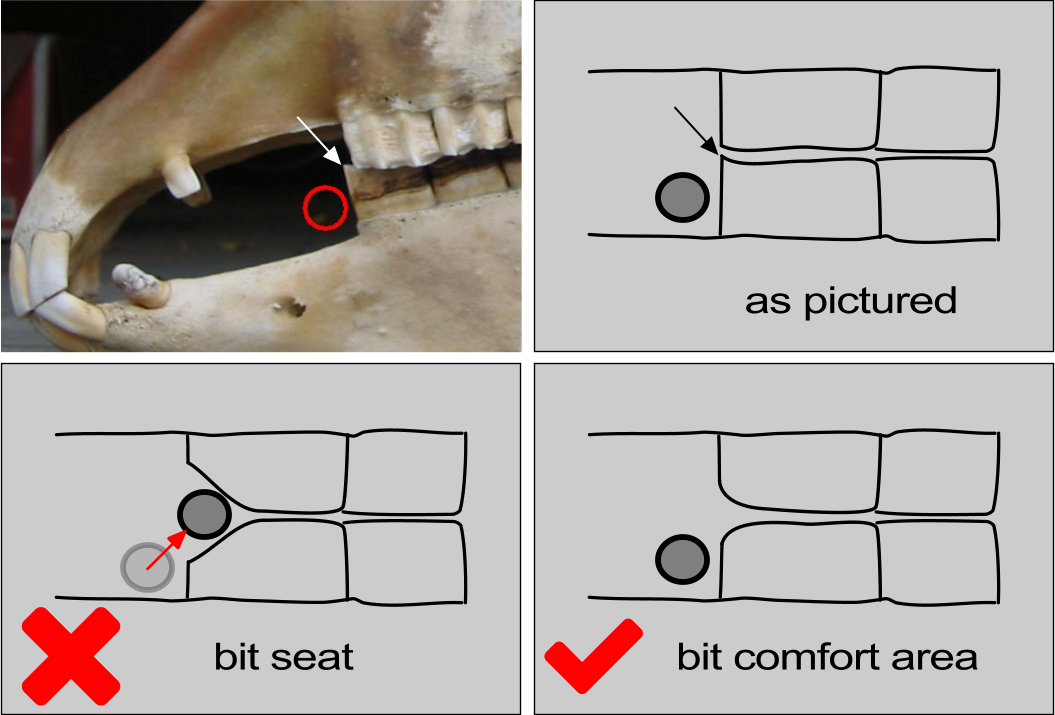
Application of a bit in the horse's mouth can lead to unintended consequences. So, when fitting a bit we have to consider the shape of the bit in relation to the shape of the mouth as well as the areas that the bit puts pressure on and, finally, the response of the horse to the bit. All factors warrant careful examination but in this article we will only consider the lips and cheeks in relation to the teeth.
Bit Positioning
For successful control of the horse with a bit, many factors need to be taken into account. We cannot expect compliant behaviour if all elements of bit use are not properly addressed. Bit type, thickness and width, bridle fit, dental issues and rider attitude are some of the important factors. We also need to remember that the horse's reaction to pain is flight. That means any bit use resulting in pain is likely to trigger a flight response instead of a controlled response by the horse. The bit requires a certain amount of space at the ideal location forward of the molar arcades at the corner of the mouth. In that position, it is most effective in getting better rider response as only small amounts of pressure on the bars of the mouth are used to signal the rider's intention to which the horse responds. Should the bit be further forward, behaviour is unpredictable due to aggravation if the tongue is pushed over the bit causing severe discomfort due to the tongue not being available to cushion the pressure of bit against the bars of the mouth.
The bars of the mouth are the narrow bones that bridge the space between premolars and incisors. Adjustment of the cheek straps of the bridle determine how far forward in the mouth the bit is positioned. When the bit is further back in the mouth, response may be diminished as the horse may grab or grind the bit. This can then lead to lack of response on one or both reins. This is often accompanied by subtle head-tilting to one-side. We may also find the horse putting the nose in the air and then grabbing the bit. Often, this is what a horse does to reduce pressure by the bit on the lips and cheeks as these are being pressed against molar arcades. Should the horse open the mouth, the bit may even cause the cheeks or inner folds of the lips to be pulled over the lower molar surfaces. In either situation, this may cause bruising or laceration of the cheeks.
Why a Bit Comfort Area and not a Bit Seat?
As mentioned, the best position for the bit is forward of the molar arcades. The first grinding tooth in each arcade, known as the second premolar, should prevent the bit from going back too far into the mouth. For the bit to slide between the molar arcades is undesirable as it may cause significant loss of control. Let's have a look at the main elements that we consider when attending to what we call the 'bit comfort area'.
Teeth have prominent enamel ridges on their grinding surfaces to enable them to cut the tough fibre in the pasture. When performing equine dental procedures that alter the shape of the teeth we must leave as many of these ridges intact as possible. Removing them completely from just one pair of teeth, like the lower second premolars, will also cause 1/6 of the chewing surface area of the mouth to be lost. This in turn affects masticatory efficacy. For this reason, it is only these parts that are filed in the normal mouth:
- Enamel ridges on the outer edges of the upper (pre)molars
- Enamel ridges on the inner edges of the lower (pre)molars
- Rounding the corners of the upper and lower second premolars located directly behind the bit
The last action must be done to an appropriate protocol, because aggressively removing dental material has been known to result in:
- Opening the pulp canals causing endodontal infection due to the removal of too much dental material. The pulp canals can be as little as 3mm from the tooth surface. (McGarian, R M, 2010. Investigation Into the Different Characteristics of the Number 6 Pulp Chamber of Equine Mandibular Second Premolar Teeth, in Relation to Age, Breed and Gender. BSc. Hons. Hartpury UK: Hartpury College.)
- Bit grabbing due to the bit sliding back between the teeth.
- Hypersensitivity due to contact of the bit with tooth surfaces that are in very close proximity to the pulp canals. This combines with increased sensitivity through the dentinotubules, which are the channels which transmit pressure through the tooth and provide a sensing response. Horses have been known to bolt after the aggressive creation of bit seats.
- Inner lip folds and cheeks that get forced between the teeth combine with bit pressure to lacerate or bruise the cheeks. We have found this to be very common in race horses when ring bits are used and there may be high head carriage.
